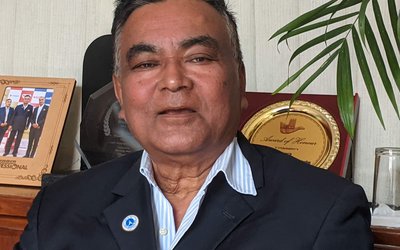More on Interview



CHANDI P. SHRESTHA, chairman of JICA Alumni Associations Forum of SAARC Countries (JAAFSC) and immediate past president of JICA Alumni Association of Nepal (JAAN), is a not a new name in Nepali Civil Service. Former home secretary Shrestha retired five years ago after serving for 28 years in civil service and making a major contribution to establish Nepal-Japan relations at the people to people level through JAAN. Shrestha went to Japan in 1984 to get a training. As Japanese Overseas Volunteers and JICA recently celebrated forty years in Nepal, Shrestha spoke to NEW SPOTLIGHT on various issues regarding the role of JICA in Nepal’s development. Excerpts:
As Japan International Cooperation Agency (JICA) and Japan Overseas Volunteers (JOCV) have recently celebrated their forty years in Nepal, how do you assess their role in the process of Nepal’s transformation?
Undoubtedly, JICA has played a incredible role in Nepal’s development process. Be it in introducing apples in Mustang or oranges (junar) in Ramechhap or coffee in Syangja, trout fish in Rasuwa and Nuwakot or strawberry in Nagarkot, JICA and Japanese Volunteers have contributed a lot. Koteshwor-Bhaktapur Road and Banepa-Sindhuli- Bardibas Road have visible impacts as projects bringing major change in Nepal’s overall development. TU Teaching Hospital, Kulekhani Hydropower and Drinking water Improvement projects in Nepal are others. Along with this, Japanese volunteers have also been working in various sectors including health posts, District Development Committees, environment, and agriculture sectors.
How do Japanese Volunteers contribute here?
Their contribution is also immense in Nepal’s development process. Hundreds of volunteers have already worked in Nepal and many are working in the country to uplift the life of rural people. A former Japanese volunteer Toru Kondo, chairperson of Society of Agriculture (MDSAC), who helped to introduce apples in Mustang district, spent almost all his life working to improve the poor people of the region. There are other Japanese volunteers, who also worked for Nepal and remained loyal to Nepal’s cause.
Do you mean Japanese aid has visible impacts in rural parts of Nepal?
Yes. Along with the big infrastructure projects, Japanese support in agriculture, health and animal husbandry sectors have enormous contribution in transforming the life of poor people. From road construction to agriculture and from health to communication and primary education, JICA has spent huge money to improve the life of poor people of Nepal. Japanese have provided support to construct school buildings. Japanese help to Nepal is visible all over the country. One cannot deny the role of JOCV to provide skills. They give know how to Nepalese farmers.
Which sector do you think JICA has been involved in mostly?
Primarily, JICA’s support is focused in areas like health, education, transport and construction of Bardibas-Dhulikhel road, one of the largest projects of JICA in Nepal. After completion of this road, the livelihood of people in Kavre, Sindhuli, Ramechap and Mahottarai will drastically change. This road will also provide an alternative to the present roads linking Nepal’s southern zone. This is going to be historic road which will shorten the distance between eastern parts of Nepal and capital Kathmandu by more than 100 kilometers. This is JICA’s one of the largest projects in the world. The government of Japan, through JICA, has been providing development assistance to Nepal since the 1970s, mainly in the areas of social and economic infrastructure, democratization and peace-building and improvement of rural living standards.
It is said that Japan’s aid to Nepal is declining now. How do you look at this?
Even Japanese have officially said that their aid to Nepal has declined. This is not only in Nepal but other parts of the world too. Of course, Japanese are now shifting their priority to the African countries. Due to Japan’s own economic problems, the volume of aid has gone down.
How many Nepalese technical experts are here who got one or other kinds of training in Japan?
There are 3700 Nepalese who got training in Japan under JICA. Out of this, we are capable to accommodate 1000.
In which sectors are these Nepalese working now?
Except Nepal Army, we have other professionals from all other sectors including bureaucrats, technicians and people from private sector. There is an Alumni Association of JICA around the world. Our aim is to promote people to people relations and use our knowledge and expertise gained in Japan in overall development of country and for the benefit of the poor people of Nepal. JICA Alumni Association is involved in the transformation of the society.
What role have you played during your two tenures as the chairman of JICA Alumni Association of Nepal (JAAN)?
During my two tenures, I took the association a little bit differently. Earlier, JAAN used to organize seminars and workshops in star hotels and organized get togethers. However, I shifted JAAN from workshop oriented organization to community based and development oriented. During my six years tenure, I shifted the paradigm of the organization. Now, we organize health camps in rural areas, support income generating activities and literacy. We choose three villages from two districts for our programs. We are launching programs in Lele and Nallu of Lalitpur and Chalnakhel of Kathmandu district. We have our own building in Balkhu. As a 37 year-old organization, JAAN has its own importance.
How are Japan’s projects different from others?
Japan’s support is different in the sense that their programs are directed to uplift the life of poor people of Nepal and to support the modernization process in development sectors. As an Asian country, Nepal shares a lot of things with Japan. This way Japan’s support is very valuable. For the last forty years, Japan always supported Nepal’s efforts to transform livelihood of poor people. They are supporting in the baseline. Their support is directed to villages, to a major change.


